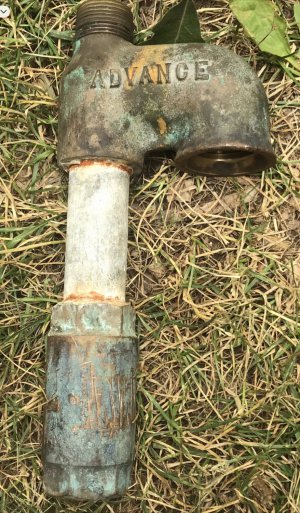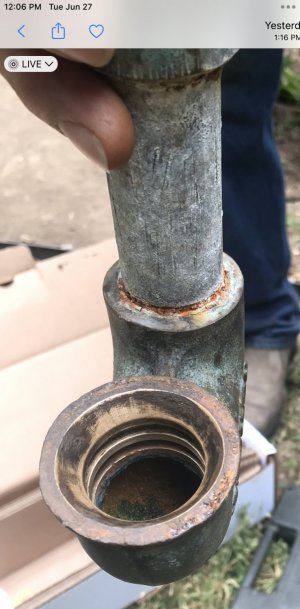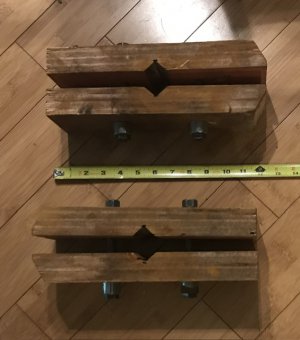Thought that I would post what I found when changing out my well pump. Had not done a submersible pump before, just jet and shallow well pumps. Researched it pretty good prior to pulling the pump. Most of the pitless adapters are a wedge type with a female 1” or 1 1/4” pipe fitting to enable pulling the pipe / pump assy from below the frost line. Mine had a male threaded section instead 7’ down from the top of the well casing. Uses 2 o-rings inside for sealing
-
Welcome back Guest! Did you know you can mentor other members here at H-M? If not, please check out our Relaunch of Hobby Machinist Mentoring Program!
You are using an out of date browser. It may not display this or other websites correctly.
You should upgrade or use an alternative browser.
You should upgrade or use an alternative browser.
Submersible Pump Pitless Adapter
- Thread starter OTmachine
- Start date
- Joined
- Jan 31, 2016
- Messages
- 13,351
Only one thing worse than running a production job , that's pulling the pump , hose and wire 340 ft up to the casing . Every time I had to do this , it was either 25 or 98 degrees .  And yes , I found about the adapter years ago the hard way when I bought the first house . I have a flower garden to this day around the well casing after digging down 6-8 feet .
And yes , I found about the adapter years ago the hard way when I bought the first house . I have a flower garden to this day around the well casing after digging down 6-8 feet .
The pump was loosing pressure, cycling a lot, three wire with a bad control box. Definitely did not want to have to do this in the middle of winter. Bought the place 11 years ago as a foreclosure and knew nothing of the wells history. Pump ohmed out low on the field side, amp draw was normal. Adapter is apparently a weld on type on the outside of the casing, male upright boss in a pocket for the coupler, (shown in picture with a check valve), ( can’t find information on the brand). I made a trial T pipe puller out of PVC to check the guesstimated threads, 1” MIP. Thread form in PVC coupler was good after screwing it on and unscrewing it to have some sort of gage. Made a working T puller out of 1” galvanized pipe. Set up my gantry crane with chain-fall 10’ above the well. Pulled up two 22’ sticks, using my two fabricated pipe clamps, (picture shown), and a nylon choker on my chain-fall, to keep from dropping the works back down the well. When I got one length up out of the well, I cut the pipe 3/4 of the way through the pipe above the clamps, after a light cut to bleed the water. Let the pipe fall like a tree, then cut off the other 1/4. The pump was apparently the original from when the house was built in 1979. I figured that the maximum that the whole assembly could weigh was about 140 lbs, seeing as how the well appeared to be 75’ deep, 7 lb per 4’ length of 1” pipe, and 30 lb for the pump. I put down 1"SIDR 11.5 160 PSI Excel Potable Water Poly Pipe using barb fittings and new wire. New control box in the house. If there is a next time, I shouldn’t need the gantry as the whole assembly now is flexible, and only weighs about 40 lbs, with a safety line. (Since I am not getting any younger). Well is actually 80’ deep, static water level at 64’. Figured that I would post this, to maybe help out someone else.Only one thing worse than running a production job , that's pulling the pump , hose and wire 340 ft up to the casing . Every time I had to do this , it was either 25 or 98 degrees .And yes , I found about the adapter years ago the hard way when I bought the first house . I have a flower garden to this day around the well casing after digging down 6-8 feet .
Attachments
- Joined
- Feb 1, 2015
- Messages
- 10,109
Several years ago, we had to have our well serviced. I was surprised to find that there are records on all private wells, including start date of service, depth of well, and depth of pump. If you contact a well driller, they may be willing to provide that information for you. It is possible that you could get that information directly from the state as well.The pump was loosing pressure, cycling a lot, three wire with a bad control box. Definitely did not want to have to do this in the middle of winter. Bought the place 11 years ago as a foreclosure and knew nothing of the wells history. Pump ohmed out low on the field side, amp draw was normal. Adapter is apparently a weld on type on the outside of the casing, male upright boss in a pocket for the coupler, (shown in picture with a check valve), ( can’t find information on the brand). I made a trial T pipe puller out of PVC to check the guesstimated threads, 1” MIP. Thread form in PVC coupler was good after screwing it on and unscrewing it to have some sort of gage. Made a working T puller out of 1” galvanized pipe. Set up my gantry crane with chain-fall 10’ above the well. Pulled up two 22’ sticks, using my two fabricated pipe clamps, (picture shown), and a nylon choker on my chain-fall, to keep from dropping the works back down the well. When I got one length up out of the well, I cut the pipe 3/4 of the way through the pipe above the clamps, after a light cut to bleed the water. Let the pipe fall like a tree, then cut off the other 1/4. The pump was apparently the original from when the house was built in 1979. I figured that the maximum that the whole assembly could weigh was about 140 lbs, seeing as how the well appeared to be 75’ deep, 7 lb per 4’ length of 1” pipe, and 30 lb for the pump. I put down 1"SIDR 11.5 160 PSI Excel Potable Water Poly Pipe using barb fittings and new wire. New control box in the house. If there is a next time, I shouldn’t need the gantry as the whole assembly now is flexible, and only weighs about 40 lbs, with a safety line. (Since I am not getting any younger). Well is actually 80’ deep, static water level at 64’. Figured that I would post this, to maybe help out someone else.
- Joined
- Jan 7, 2016
- Messages
- 3,377
I almost had to do this a week ago. My three-year-old house has a constant pressure/variable speed well pump. I noticed a couple of weeks ago that the pump was not shutting off at all but sitting there drawing about 3 amps continuously. I called my well guy, and of course, it took about a week for him to get here, but the night before he came, I had had enough of the pump running, so I shut the VFD off. The next morning I discovered that all of the water had drained out of the lines in the house, but when I started the pump back up, it came up to pressure and shut off. Apparently, some debris was stuck in a check valve at the pump (80 feet down), so when I turned the pump off, it back-flushed the pump lines and fixed itself. Phew!
- Joined
- Feb 1, 2015
- Messages
- 10,109
When I redid our water system, I installed a second check valve in the basement. Two years ago, the steel fitting from the well casing to the plastic pipe coming into the house had rusted through causing the pump to run longer. The check valve prevented back flow but the appearance of a wet area was the clue that something was amiss.
We called the well guy and he was out the next day with a tracked backhoe. The steel pipe nipple was threaded into a cast iron fitting and galvanic action had eaten the interface to a tissue paper like thickness. He was able to unscrew the remnant of the nipple and replaced it with a brass nipple, assuring me that I wouldn't see further galvanic corrosion. The service call cost us around $300.
Two years before that, our well had failed. The steel pipe had corroded away below the donut and 80 ft. of pipe and the pump dropped to the bottom of the well, breaking the wires in the process. We called the pump guy and they were out the same day. The guy managed to thread a tap into the pipe some 40 ft below and pulled the pipe and pump up. He installed PVC pipe to replace the old pipe and a new pump as well. The entire service call was $1600 which I thought was very reasonable, considering what was involved.
We called the well guy and he was out the next day with a tracked backhoe. The steel pipe nipple was threaded into a cast iron fitting and galvanic action had eaten the interface to a tissue paper like thickness. He was able to unscrew the remnant of the nipple and replaced it with a brass nipple, assuring me that I wouldn't see further galvanic corrosion. The service call cost us around $300.
Two years before that, our well had failed. The steel pipe had corroded away below the donut and 80 ft. of pipe and the pump dropped to the bottom of the well, breaking the wires in the process. We called the pump guy and they were out the same day. The guy managed to thread a tap into the pipe some 40 ft below and pulled the pipe and pump up. He installed PVC pipe to replace the old pipe and a new pump as well. The entire service call was $1600 which I thought was very reasonable, considering what was involved.
I was figuring $2000 + and a torn up yard, from a truck or Track Hoe. Cost me $750, and I learned some new things. Took six hours for my brother and I with a break. Yes, I am cheap.But think how much you saved not having to call someone out to pull the pump. It is a lot easier with out having a well pit. Just a one man job if it’s poly pipe with a safety rose.
Had a well pit in Colorado which worked good though, using a jet pump .
- Joined
- Mar 22, 2014
- Messages
- 879
Yes, I have pulled the pump 3 times in the 35 years we have lived here, including once in winter. Our pump is only 80 feet down, so it is not too bad.
What's worse, the hose from our house to the well has failed twice. Each time the failure was a Nylon coupling that the builder had used (cheap jerk). I was up to my nose in a muddy hole. My neighbors enjoyed the spectacle.
What's worse, the hose from our house to the well has failed twice. Each time the failure was a Nylon coupling that the builder had used (cheap jerk). I was up to my nose in a muddy hole. My neighbors enjoyed the spectacle.
Last edited:
Similar threads
- Replies
- 7
- Views
- 218
- Replies
- 7
- Views
- 254
- Replies
- 0
- Views
- 70



